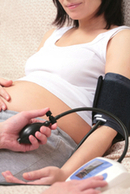Pre-eclampsia is a condition of pregnancy and affects many women worldwide. This article explains pre-eclampsia and the implications for mother and baby
What is pre-eclampsia?
Pre-eclampsia is a common problem in pregnancy, usually affecting first pregnancies and occurring in as many as 10% of pregnant women in some areas of the world. It most commonly causes raised blood pressure and protein in the urine. The cause is as yet unknown, although it is thought to be linked to the placenta. It is sometimes called toxaemia and or pre-eclamptic toxaemia, or PET.
Early onset pre-eclampsia can occur any time after 20 weeks of pregnancy, but most commonly pre-eclampsia occurs after 32 weeks. Dealing with prematurity is therefore often a complicating factor in pre-eclampsia.
Hypertension of pregnancy refers to raised blood pressure only, which did not exist prior to pregnancy.
Essential hypertension means that the woman already had high blood pressure, prior to pregnancy.
What are the signs & symptoms of pre-eclampsia?
Often women with pre-eclampsia do not have any reported symptoms and the signs of pre-eclampsia are picked up by midwives/doctors at routine ante natal check ups.
The main signs of pre-eclampsia are –
Raised blood pressure – either a diastolic blood pressure of 90 (this is the lower number which reflects the pressure in the arteries when your heart relaxes between beats), or a diastolic blood pressure (BP) which is 20mm higher than when your BP was first checked in early pregnancy (booking blood pressure).
Protein in the urine – this shows up on the dip sticks that health professionals use to test urine, or can be accurately measured by collecting 24 hours of urine then having total protein content measured – this should not exceed 300mg protein in 24 hours.
The kidneys act like a sieve and healthy kidneys do not let large protein molecules pass through them into the urine. Protein in the urine therefore indicates kidney damage. Blood tests will confirm this.
Swelling or oedema – if the small capillaries in the limbs are damaged then proteins and fluid may leak from the blood vessels into the surrounding tissue, causing swelling of arms, legs and face.
If 2 of these signs are present then pre-eclampsia is usually diagnosed, particularly raised blood pressure and protein in the urine (also called proteinuria).
Some women may report the symptom of upper abdominal pain, on the right ride. This is a serious symptom which may indicate liver involvement and should be reported immediately. It can be confused with heartburn, but liver pain does not extend to the throat area and is not relived by antacids, such as Mylanta.
| Find the Right Pregnancy & Birth Book for You!
Click here for the Most Popular International BestSellers |
||||
 |
 |
 |
||
What is the treatment for pre-eclampsia?
As the cause of pre-eclampsia is as yet unknown, the treatment is difficult. The only known ‘cure’ is to deliver the baby and placenta. This often has to be juggled with the need for a premature baby to stay in the womb to mature and develop safely. Whilst the well-being of the mother must always remain paramount, there is often a delicate balancing act between giving the baby as long as possible in the womb and ensuring that the mother is not put at risk of the condition worsening.
Blood pressure medication is often prescribed. Whilst this does not treat pre-eclampsia, it does lessen the risk of blood pressure complications.
The well being of mother and baby are closely monitored:
- Regular blood pressure checks
- Measurement of protein levels in urine
- Blood tests to monitor kidney and liver function
- Close monitoring by mum of baby’s kicks
- Regular heart beat checks on the baby (cardiotocograph, or CTG)
- Scans may also be necessary to check on fetal growth.
If delivery is being considered and baby is premature (particularly before 32 weeks) then the mother will usually be given 2 steroid injections 12-24 hours apart, which help to mature the baby’s lungs. Whenever possible the birth will be delayed for 24 hours to enable the steroids to be effective.
Induction of labour and emergency Caesarean section are therefore both a major part of ‘treatment’ for pre-eclampsia.
What are the risks and complications of pre-eclampsia?
The greatest risk associated with pre-eclampsia is a worsening of the condition resulting in an eclamptic fit, or eclampsia. It may be sudden in onset, or may be preceded by increased blood pressure, a headache and blurred vision.
This is similar to an epileptic fit and it puts the health of mother and baby at risk. The treatment for this condition, which is rare, is stabilisation of the mother using drug therapy (magnesium sulphate and muscle relaxants) and immediate delivery of the baby, whatever the gestation.
Other risks associated with pre-eclampsia are:
- Poor growth of baby, related to high blood pressure
- Damage to blood vessels, particularly the kidneys
- Premature delivery
- Damage to the blood vessels in the woman’s brain, resulting in a stroke (this is extremely rare)
- The risk of still birth is increased with pre-eclampsia (again this is very rare in New Zealand, due to careful monitoring of all pregnant women).
What can I do help myself and my baby if I have pre-eclampsia?
- Rest is crucial – not constant bed rest, but taking it easy will often lower blood pressure
- Keeping a close eye on baby’s movements is the most important thing any mother can do. Just like a sick toddler, a poorly nourished baby will lie still in the womb, or move less often.
- Report any symptoms to your midwife or doctor – blurred vision, headaches, swelling or pain in the abdomen – particularly under your right ribs.
Pre-eclampsia can be frustrating. The mother feels well and yet everyone is making a fuss and telling her to rest and she may even be advised to remain in hospital for the rest of the pregnancy. However, no one wants that, so if you are being advised to stay in hospital, then there is a good reason and the health professionals are thinking only of the well being of you and your baby. Of course the implications for whanau/family can be huge, particularly if there are other dependent children who need to be cared for.
Can I still have a normal birth if I have pre-eclampsia?
Many women with pre-eclampsia are carefully monitored through the remainder of their pregnancy and continue to give birth naturally and return to normal quickly after the birth.
Some women are induced when they reach ‘term’ – from 37 weeks onwards – as baby will usually will cope well with birth after this time. Induction of labour for pre-eclampsia is often quick and successful, as though the body knows it is time to give birth and so end the pregnancy. Many women in this situation are advised to have an epidural, as it lowers the blood pressure during labour.
Some women inevitably do need a Caesarean section:
- This may be an emergency for sudden worsening of the signs and symptoms of pre-eclampsia in pregnancy
- It may be an emergency in labour, for either a sudden rise in blood pressure, or a failed induction (the woman’s body does not respond to the drugs and therefore labour does not go well), or fetal distress.
Much of what happens around the birth when a woman has pre-eclampsia is out of her control. Your LMC will support you through this time and help you to achieve the best birth experience possible in what can be difficult circumstances.
Useful articles
To learn more about the Growth of Baby in pregnancy, click here
Induction of Labour is common with pre-eclampsia – visit our Kiwi Families article for more information
Some women with pre-eclampsia have a Caesarean Section – our article under the Birth section will tell you more about what to expect.
To read more about Epidurals, click here










I didnt even feel my first baby till about 24 weeks, you feel it easier the more children you have had. My first barely kicked much at all, and he was a good size and very healthy. Dont worry 🙂
I’m currently 20 weeks. I’m a little worried that the baby is not moving enough. This is my first pregnancy and although sometimes I think the baby is definitely moving other times I’m not sure if its just wind. I did have a scan last week and everything was apparently looking fine, the baby was not moving as much as my previous scans but was it was moving. Do you think it’s possible that the baby is not active enough or not getting enough nutrition from the placenta resulting in it being less active?